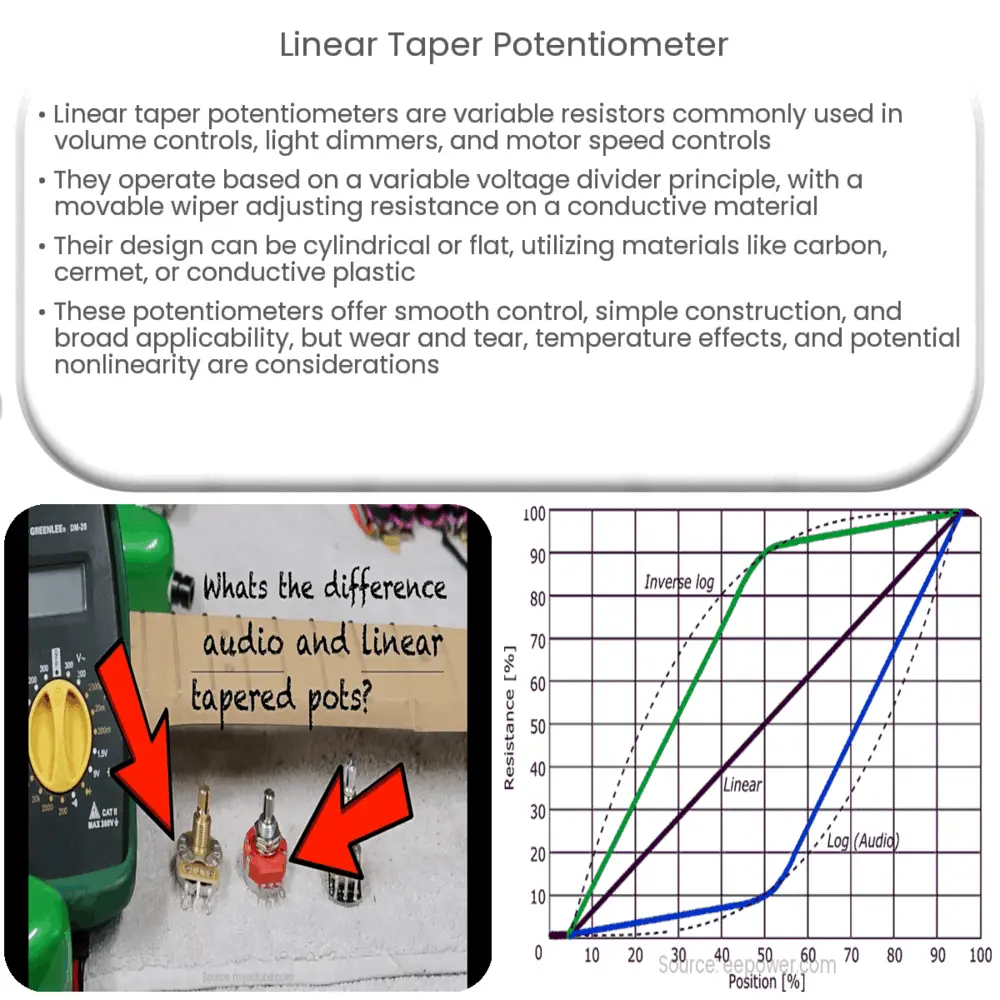A linear taper potentiometer is a variable resistor used for smooth, continuous control in applications like volume adjustment, light dimming, and motor speed regulation.

Linear Taper Potentiometer: An Overview
Introduction
A linear taper potentiometer, also known as a linear potentiometer or linear variable resistor, is a type of variable resistor that is commonly used for controlling electrical devices such as volume controls on audio equipment, light dimmers, and motor speed controls. It allows users to adjust the resistance between two points in a linear manner, providing a smooth and continuous change in output signal or voltage. In this article, we will explore the working principle, construction, applications, and advantages of linear taper potentiometers.
Working Principle
Linear taper potentiometers operate on the principle of a variable voltage divider. The potentiometer consists of a resistive element, often made from a thin layer of conductive material such as carbon or metal, which is wound around an insulating support. A movable wiper, typically made of metal, makes contact with the resistive element and slides along its surface as the potentiometer is adjusted. As the wiper moves along the resistive element, the resistance between the wiper and the two ends of the resistive element changes linearly, thus providing a variable output voltage or signal.
Construction
Linear taper potentiometers are typically constructed using a cylindrical or flat design. In a cylindrical design, the resistive element is wrapped around an insulating support, forming a circular shape. The wiper is then placed on the surface of the resistive element and is moved by rotating the potentiometer’s shaft, which is connected to a control knob. In a flat design, the resistive element is laid out in a straight line on an insulating support, and the wiper is moved along the resistive element by sliding a control mechanism, such as a slider or fader.
Linear taper potentiometers can be designed with various materials for the resistive element, such as carbon, cermet, and conductive plastic. Each material offers its own advantages and disadvantages in terms of durability, noise, and temperature coefficient. The choice of material depends on the specific requirements of the application and the desired performance characteristics.
Applications
Linear taper potentiometers are widely used in a variety of applications, including:
- Volume Controls: One of the most common uses for linear taper potentiometers is in audio equipment, where they are used to control the volume of audio signals. This allows users to adjust the volume smoothly and continuously without sudden jumps in loudness.
- Light Dimmers: Linear taper potentiometers are also used in light dimming circuits, allowing users to adjust the brightness of lights in a smooth and continuous manner.
- Motor Speed Controls: In some applications, linear taper potentiometers are used to control the speed of motors, such as in power tools, fans, or robotic systems.
Advantages of Linear Taper Potentiometers
Linear taper potentiometers offer several advantages over other types of variable resistors and control devices, including:
- Smooth and Continuous Control: Linear taper potentiometers provide a smooth and continuous change in output voltage or signal, making them ideal for applications that require precise and gradual adjustments, such as volume controls or light dimmers.
- Simple Construction and Operation: The construction of linear taper potentiometers is relatively simple, which makes them easy to manufacture and use. Additionally, their operation is straightforward, requiring only the movement of the wiper along the resistive element to adjust the resistance.
- Wide Range of Applications: Due to their versatility and simplicity, linear taper potentiometers are used in a wide variety of applications, from consumer electronics to industrial equipment.
Limitations and Considerations
Despite their advantages, there are some limitations and considerations to be aware of when using linear taper potentiometers:
- Wear and Tear: Over time, the wiper and resistive element can experience wear and tear, which can lead to increased noise and decreased performance. Choosing a potentiometer with a suitable material for the resistive element can help mitigate these issues.
- Temperature Effects: Changes in temperature can affect the resistance of the potentiometer, leading to variations in the output signal or voltage. This can be mitigated by choosing a potentiometer with a low temperature coefficient or by using temperature compensation techniques.
- Nonlinearity: While linear taper potentiometers are designed to provide a linear change in resistance, there may still be some degree of nonlinearity, especially near the ends of the resistive element. This can lead to inaccuracies in the output signal or voltage, which may need to be compensated for in some applications.
Conclusion
Linear taper potentiometers are versatile and widely-used components in the world of electronics. They provide a simple and effective means of controlling electrical devices in a smooth and continuous manner. Their straightforward construction and operation make them an attractive choice for a wide range of applications. However, it is important to consider the limitations and potential issues that may arise from wear and tear, temperature effects, and nonlinearity. By understanding these factors and choosing the appropriate potentiometer for a given application, designers can harness the full potential of linear taper potentiometers in their projects.

